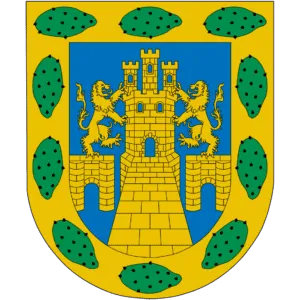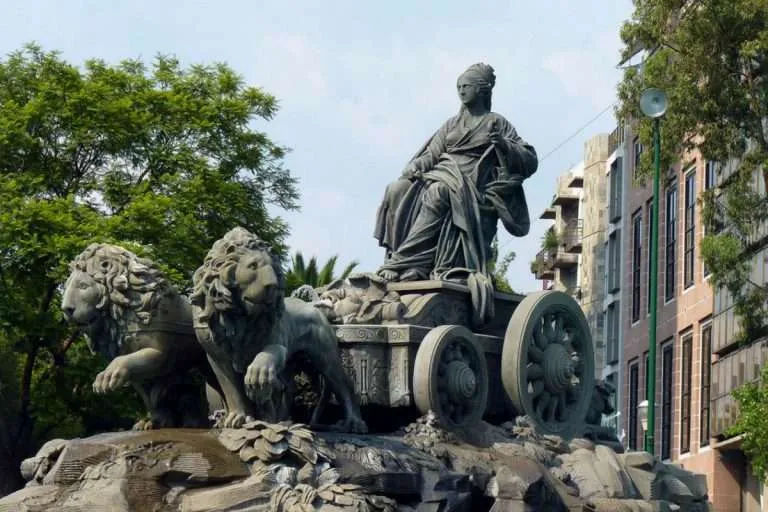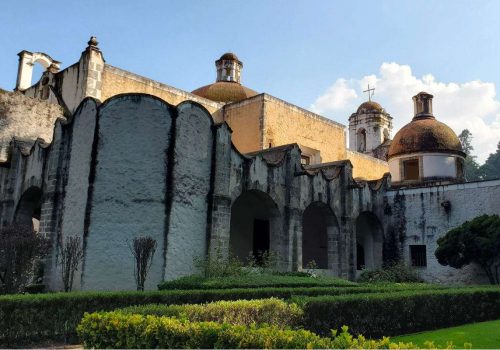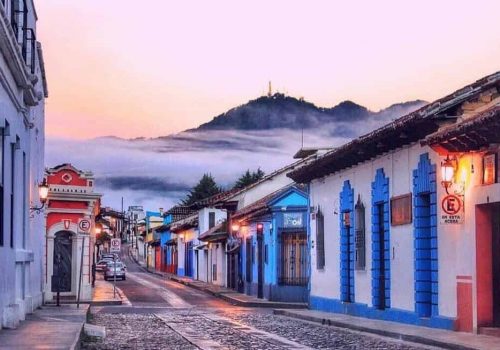Choose the Zone of Mexico City you want to explore:
Mexico City is the vibrant, multifaceted and ever-changing capital of the country, the political, economic and cultural core of the Mexican Republic.
The city keeps among its streets and long avenues the secrets and events that have shaped the nation.
Mexico City, besides being one of the largest cities in the world, is also a place full of beauty and natural resources.

In fact, 59% of the city's territory is considered conservation land, equivalent to more than 88 thousand hectares, which is the reservoir of 12% of the national biodiversity and 2% of the world's biodiversity.
In addition, the city has 25 Natural Protected Areas and 7 Community Ecological Conservation Areas.
Mexico City's physical and natural characteristics allow it to position itself in this segment with a wide range of attractions, services and tourism experiences for adventure, ecotourism and rural tourism.
 Activities in Mexico City
Activities in Mexico CityMexico City is the most important urban center in the country, as well as the political, economic, cultural, academic and business center.
It has 160 museums, 100 art galleries, 30 event and convention spaces, and 21 magical neighborhoods.
The symbol of the city is the Independence Angel on Reforma Avenue. The most visited places are Mexico City's Zócalo and Chapultepec Forest.
And millions of people make pilgrimages every year to the Basilica of Guadalupe to give thanks to the Virgin of Guadalupe.
It can be divided into 28 tourist zones, where each one forges the multi-cultural character of the CDMX.
The most relevant are: Centro Histórico, Alameda, Polanco-Chapultepec, Reforma-Zona Rosa, Roma-Condesa, Xochimilco, Coyoacán, Ciudad Universitaria, San Angel, Tlalpan, Zona Norte, Villa de Guadalupe... among others.
There are people who have lived in Mexico City for a lifetime and still haven't gotten to know it - that's how BIG Mexico City is!
For all first-time visitors to the city, we recommend a minimum of 5 days and an average of 10 days to get the basics.
We recommend exploring by zones at a time, rather than trying to see several attractions far away from each other, as the city traffic may ruin your idea of a quick exploration.
There are more than 1,000 hotels in Mexico City. There are hotels for all tastes and budgets.
If your visit to Mexico City is for several days and your intention is to visit as many tourist attractions as possible, we recommend staying in different hotels and in different zones. There are 28 tourist zones in the city.
Stay in Reforma and feel the modernity of this avenue. Stay in downtown and go back to the colonial era of its streets. Stay in Polanco and experience the luxury of its exclusive stores. In Roma - Condesa you will appreciate the hipster and youthful area. And in Coyoacán you will breathe bohemian airs. Among many other areas.
Feel safe to explore Mexico City and see the most emblematic sites aboard open-top tour buses.
Choose the Zone of Mexico City you want to explore:
 Mexico City Historic Center
Mexico City Historic CenterMexico City's Historic Center is the largest and most emblematic in all of Latin America and is one of the most important tourist centers in the world.
This is the main destination for cultural tourism in Mexico. It is home to some of the nation's most prized cultural treasures and true architectural gems.
It is a World Cultural Heritage Site and has about 1,500 buildings, including temples, museums, hotels, stores, galleries, theaters and cultural centers, many of which are listed as historical or artistic monuments of the nation.

–
Don't miss out on:
 Alameda | Tabacalera - Mexico City
Alameda | Tabacalera - Mexico CityThe magnificent Alameda Central is one of the jewels of Mexico City, take a pause and find a moment to appreciate the beauty of this beautiful park that was a place of recreation for the colonial aristocracy.
In this area is the Palacio de Bellas Artes, an art nouveau jewel on the outside, art deco on the inside, with a pleasant esplanade adorned by sculptures. It is a meeting point for city dwellers.
Whichever way you look there is a must-see: to the east of the Palace of Fine Arts, the Postal Palace; to the north, the Franz Mayer Museum, the National Museum of Prints and more.

 Reforma | Zona Rosa - Mexico City
Reforma | Zona Rosa - Mexico CityConnecting the Alameda Central to the Chapultepec Forest is Reforma Avenue.
This avenue is full of roundabouts that are symbols of the city: the Caballito, the Diana Cazadora, the Independence Angel, as well as large office buildings, hotels and restaurants.
On the south side of Reforma is the Zona Rosa, one of the most elegant neighborhoods of the city during the Porfiriato.
The Zona Rosa is a bohemian neighborhood where great Mexican artists have lived and for decades, the Zona Rosa has been the center of the LGBT community.

 Roma | Condesa - Mexico City
Roma | Condesa - Mexico CityLa Colonia Roma has an effervescent cultural activity. Artists, designers, photographers and more come from all over Latin America to stay.
In this neighborhood, luxury coexists unashamedly with the alternative. Here is Casa Lamm, graffiti decorates facades and shutters and the food is popular, organic or both. There are also other emblematic spaces such as MODO or Mercado Roma.
La Condesa is full of art deco architecture. In its heart, the Mexico Park and its Amsterdam belt, are a sample of this artistic movement that is present in every detail.
Aesthetics are important here, so, in addition to the fascinating urban landscape, interior design, art and design are protagonists of the neighborhood in vintage furniture stores, art galleries, stores and designers' studios.

Brick Hotel – Web Site
Casa Dovela – Web Site
Casa Goliana – Web Site
Flow Suites Condesa – Web Site
Four Points Sheraton Roma Norte – Web Site
Hotel Condesa DF – Web Site
Hotel Villa Condesa – Web Site
La Valise Hotel – Web Site
Nima Local House Hotel – Web Site
The Red Tree House – Web Site
Vasconcelos 65 – Web Site
 Polanco | Chapultepec - Mexico City
Polanco | Chapultepec - Mexico CityChapultepec and Polanco, at first glance are antagonistic areas, but they are intimately connected. A chain of cultural venues connect Chapultepec, the great lung of Mexico City, with the rest of the city starting with Polanco, its most cosmopolitan neighborhood.
Chapultepec is the great iconic forest of Mexico City. The place for sports. Kilometers of trails, lakes, the Castle, the Zoo, the large parks, art and culture venues, along with the National Auditorium and the Luis Barragán Studio.
While in Polanco you will find, among Californian colonial-style mansions and modern buildings, decoration stores, art galleries, embassies, luxury brands, the most avant-garde museums, such as the Soumaya Museum, and a great scene of restaurants and cafes.

 Coyoacán - Mexico City
Coyoacán - Mexico CityWhen you visit Coyoacán you will find a place full of history, charm and legends. From the time of Hernán Cortés until today, visitors from all over the world have been captivated by the beauty of the place.
Coyoacán was a refuge for artists; Octavio Paz used to walk through these streets and here is the birthplace of Frida Kahlo and the Museo Casa de León Trotsky.
The center of Coyoacán is marked by the Jardín Hidalgo, in what was once the atrium of the former convent and the parish of San Juan Bautista.
There is always a relaxed atmosphere, a meeting place for coffees, meals and gatherings on the terraces of the restaurants, in the market of antojitos or in one of the most traditional cantinas of the city.

 Xochimilco - Mexico City
Xochimilco - Mexico CityXochimilco is chinampas, trajineras, museums, flower and plant markets, parishes, parks and forests.
The canals of Xochimilco and the traditional chinampas cultivation system are World Cultural Heritage.
More than 200 colorful trajineras depart from its ten piers to travel along the canals, whose routes reach the chinampas or the Isla de las Muñecas (Island of the Dolls).
Along the way, visitors can eat, celebrate with family or friends, sing with a mariachi band, or simply enjoy the beautiful scenery. There are few things in Mexico City as traditional as this.

* Arriving in Xochimilco there are many vendors on motorcycles, bicycles or on foot who offer to take you to a pier. We do not recommend as it will be more expensive since they take a commission.
* $500 pesos is the official price for 1 hour per trajinera and not per person. This is a common scam. And it is easy to negotiate the price for less money.
* If you want to visit Isla de las Muñecas you must take the long duration Ecological Routes. Since this island is not so close to the traditional tourist area.
There are 10 piers. All are different in size, and in the experience they offer.
In classic tour, i.e. the walk with party and mariachis, you can go to Nativitas or Las Flores Pier. For a very quiet ride and more focused on the nature, pick Cuemanco Pier.
That is why you have to choose the Xochimilco pier according to what you are looking for: the tourist canals or the protected natural area.
Here you can take a traditional tour of Xochimilco with mariachis and other musical groups. (festive atmosphere).
Piers:
Nuevo Nativitas is the largest pier, with a handicraft market, a large parking lot, several restaurants around.
Salitre, San Cristóbal, Belem and Belem de las Flores are all easily accessible from the center of Xochimilco.
–
Protected Natural Area Canals
Here the tours allow you to discover the Xochimilco ecological park, is a reserve of 200 hectares, where different species of birds can be found.
It is also an opportunity to see the traditional agriculture that has been preserved in the chinampas.
They are much less touristic routes, and the ideal place to make ecotourism in Xochimilco.
Piers:
Cuemanco is the largest pier for going to the Xochimilco reserve, but it is quite quiet because there are few boats. There is no music or food here, to preserve the area.
Cuemanco is also known for its flower, cactus and succulents market, one of the Mexico City's largest plant markets.
Approximate costs, subject to change:
Shared boats (with capacity for 60 people) that go back and forth between the Nativitas pier and the Salitre pier.
– Cost: 30 pesos (30min one way) or 60 pesos per person (round trip).
Great option to visit Xochimilco on a budget.
This is the classic trajinera tour (with capacity for 20 people) through the canals of Xochimilco.
Several boats will offer you food and music. You can bring your own food and drinks.
The 1 hour tour is round trip along the same path. The 2 or 3 hour tour will allow you to watch more and better canals.
The official price is $500 pesos per hour, per trajinera.
This route passes through the ecological zone of Xochimilco, that the Tourist Route is much quieter.
In this type of route you will be able to observe the numerous birds, visit the greenhouses, lakes (depending on the starting point) and see some attractions: Ajolotario, Chinampa Interactiva, the Ajolote Museum or the Isla de las Muñecas.
Average cost: From $1,800 pesos for 4 hours, up to 2,200 pesos for almost 6 hours.
Yes, you can bring your own food. The other option is to buy it right there at the pier of your choice, or from one of the many vendors that pass by with their boats. There are trajinera packages that also include food.
Yes, you can bring all drinks (alcoholic or non-alcoholic), at no additional cost. The same applies to food.
Generally yes, and they regularly charge $5 pesos, and during the tour ask the person who drives the trajinera.
A mariachi song usually costs $150 pesos, they also offer 4 song packages for $520 pesos. Marimba is cheaper, usually $70 pesos per song or 4 song packages for 200 pesos.
In general the trajineras are available from 7:00 am to 7:00 pm. It is also possible to take night tours between 7:00 p.m. and midnight, but reservations must be made in advance.
- In the main square of Xochimilco is the 16th century Cathedral and Ex-Convent of San Bernardino de Siena.
- The Chapel of Our Lady of the Rosary from the 18th century
- Eating at the Xochimilco market
- Drinking Pulque at El Templo de Diana - Facebook
- Visit a flower market, in Xochimilco there are 4:
–
- Dolores Olmedo Museum - Web Site
 San Ángel | Ciudad Universitaria - Mexico City
San Ángel | Ciudad Universitaria - Mexico CitySan Angel was born around the Ex-Convento del Carmen. Narrow cobblestone streets. Beautiful colonial style mansions with large gardens and delicate railings.
Tree-lined squares ideal for a moment of rest. Flower markets. An idyllic place that attracted Diego Rivera and Frida Kahlo, where they built their homes.
Today San Angel is one of the favorite places for locals and tourists on weekends.
While the campus of the National Autonomous University of Mexico - heir to the oldest university in New Spain - has been declared a World Heritage Site, for being an "exemplary monumental complex of 20th century modernism".

 Basílica de Guadalupe - Mexico City
Basílica de Guadalupe - Mexico CityThe Basilica of Guadalupe is one of the main holy places of Catholicism.
it is the second most visited temple in the world after St. Peter's Basilica in Rome, Italy, it receives 40 million visitors each year, including pilgrims and tourists.
Every day thousands of people go up the Calzada de Guadalupe on pilgrimage.
The Virgin appeared to Juan Diego Cuauhtlatoatzin on the Tepeyac Hill, where Tonantzin was worshipped before.


Nowadays, the Villa de Guadalupe is a complex of religious precincts that includes:
The Basilica itself, the Indian Chapel, the Cerrito Chapel, the Tepeyac Cemetery, the Pocito Chapel, the Temple and former convent of the Capuchinas, the Expiatory Temple to Christ the King, the Basilica Museum, the Baptistery and the Plaza Mariana.
The Basilica is of modern construction. It was designed to house 10,000 faithful and to allow from any point to admire the famous and mysterious cloth with the image of the Virgin, which today continues to intrigue the world.
 Poniente | Santa Fe - Mexico City
Poniente | Santa Fe - Mexico CitySanta Fe is one of the most exclusive areas of the city.
Large corporations, luxury hotels, modern avant-garde apartment towers, excellent restaurants and large shopping malls with luxury brands, leisure spaces and everything you could want or need are located here.
Thousands of people come from all over Mexico to do their business in Santa Fe, spend a weekend shopping, stroll through the most exclusive side of Mexico City, or participate in one of the macro-events organized there.
If you want to combine shopping, fine dining, spas, day and night entertainment for you and your family, this is your ideal destination.


The Desierto de los Leones is one of the best preserved forests in the country.
In the center of this magnificent National Park is located the shell of what was once a convent dedicated to meditation, to a close encounter with God and His creation: the ex-convent of Nuestra Señora del Carmen de los Montes de Santa Fe (better known as the ex-convent of Desierto de Los Leones).
A magnificent 17th century building transformed into a tourist center with a wide variety of cultural activities.. It is the ideal place to spend a weekend enjoying the outdoors and the colors of the forest.

Iztapalapa, CDMX

Tlalpan, CDMX

Benito Juárez, CDMX

Cuauhtémoc, CDMX

Cuauhtémoc, CDMX
City | Distance in Km | Miles | Time in Hours |
|---|---|---|
Toluca EDOMEX | 63 Km | 39 Mi | 1 Hour |
Cuernavaca Morelos | 87 Km | 54 Mi | 1 hora 20 minutos |
Pachuca Hidalgo | 91 km | 57 Mi | 1 Hora 25 Minutos |
Puebla City | 135 km | 84 Mi | 2 Horas |
Ciudad de Querétaro | 208 km | 129 Mi | 2 Horas 40 Minutos |
City | Distance in Km | Miles | Time in Hours |
|---|---|---|
Tepotzotlán EDOMEX | 40 Km | 25 Mi | 20 minutos |
Teotihuacán EDOMEX | 48 km | 30 Mi | 50 Minutes |
Metepec EDOMEX | 60 km | 38 Mi | 1 Hour |
V. del Carbón EDOMEX | 66 km | 41 Mi | 1 Hour 30 Minutes |
Zempoala Hidalgo | 83 km | 51 Mi | 1 Hora 10 Minutos |
Mexico City is one of the most fascinating cultural destinations in the world.
It is one of the three cities with the largest number of museums in the world, it also has a priceless historical legacy, a gastronomic offer applauded worldwide and hundreds of places to make the most of your stay in the country's capital.

Aguascalientes

Campeche

Chiapas

Chiapas

Querétaro

San Luis Potosí

Tlaxcala

Veracruz
The country is a land of contrasts. It has it all: a rich history and culture, a warm and pleasant climate, a varied geography, an impressive nature, a tasteful gastronomy and a friendly and helpful population ... in short: Mexico can fulfill all your wishes!